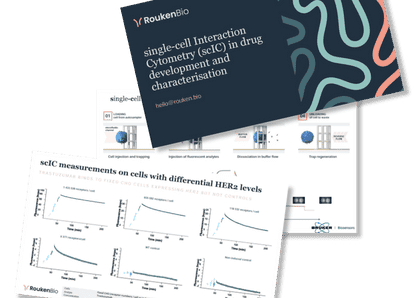Target density matters: Binding kinetics of antibody-based therapeutics are highly influenced by target expression levels
Understanding how antibody-based drugs interact with targets at different expression levels is key to optimising their safety and efficacy. Traditional methods struggle to measure binding kinetics in real cellular environments. This study uses the IndEx-2 system and single-cell Interaction Cytometry to reveal how target density affects drug binding in a more physiologically relevant context.

|
July 16, 2025
|
5 min read
Understanding how antibody-based therapeutics interact with their targets at varying expression levels is vital for optimising tissue and cell-specific drug efficacy and safety. Traditional methods, such as SPR, BLI and QCM, face limitations when assessing binding kinetics in cellular environments due to challenges with sensitivity, throughput and physiological relevance.
To address these gaps, this study explores the impact of target density on therapeutic binding kinetics using the novel IndEx-2 system and single-cell Interaction Cytometry (scIC). This integrated approach provides real-time kinetic data in a cellular context, offering critical insights into drug performance under conditions that closely mimic tumour heterogeneity.
The importance of target density and limitations of traditional methods
Limitations of traditional methods are mainly logistical (access & cost) and methodological (expression range & cell line background).
Understanding antibody-based therapeutics’ behaviour under varying target expression levels is crucial for effective tissue and cell-specific targeting. Traditional in vitro evaluations often rely on cancer cell line panels with differing receptor levels, which can be logistically challenging and yield inconsistent results.
Standard techniques like SPR are poorly suited for analysing molecule binding to eukaryotic cells, as detection depth (~200 nm) covers only ~2% of a typical 10–20 μm cell and unstable immobilization limits SPR to cell attachment studies. Similar limitations apply to BLI and QCM. Other cell-based binding technologies have not gained widespread adoption due to challenges in automation, sensitivity, and throughput.
Measuring how binding is influenced by differential target expression is critical for tumour-targeting therapeutics, as antigen density impacts safety through on-target, off-tumour toxicities and affects efficacy by enabling tumour escape at low target expression levels.
CIP-based systems for titratable expression
The purpose of this study was to investigate how target antigen density influences the binding kinetics of therapeutic molecules under physiologically relevant conditions, addressing limitations inherent to traditional kinetic assays listed above. To achieve this, we utilised the novel IndEx-2 system, which employs CHO-K1 cells engineered for tuneable expression of one or two target antigens via chemically induced proximity-mediated induction.
Controlled expression of HER2
Induction of HER2 expression was achieved by the addition of varying concentrations of a small molecule inducer for approximately 24 hours. Cells were stained with labelled antibody and expression levels quantified using a bead-based quantification kit.
Single-cell Interaction Cytometry (sc-IC)
This was paired with single-cell Interaction Cytometry (scIC), a unique biosensor-based technology that measures real-time binding directly on captured cells. By combining these two systems, we examined the binding kinetics of trastuzumab to HER2 expressed at varying levels, serving as a model for tumour heterogeneity.
HER2 expression was quantified using flow cytometry, while scIC was used to perform kinetic measurements on the same cells. The analysis revealed that higher HER2 expression levels prolonged trastuzumab residence time due to avidity effects. Notably, differences in affinity (Kd) across HER2 densities were driven by variations in the dissociation rate (koff), rather than the association rate (kon), underscoring the critical influence of target density on binding kinetics.
Trastuzumab binds to HER2 on cells
Fluorescently labelled trastuzumab was passed over captured cells at three different concentrations followed by an extended injection of buffer to follow dissociation. Trastuzumab bound all four HER2 expressing cells. Controls included a wild-type CHO-K1 cell line as well as an un-induced control.
Expression level affects signal amplitude
When normalising the fluorescence signal to the number of cells, the amplitude of the signal observed directly relates to the number of receptors per cell. More receptors present more binding sites for trastuzumab and therefore a higher signal is measured.
Expression level affects kinetics
Cells with the lowest receptor number have the highest KD and therefore lowest affinity whereas cells that have the highest receptor numbers have the lowest KD and therefore highest affinity. The on-rates are very similar for all four cell densities.
Off-rates drive the differences; the lower the receptor number, the faster trastuzumab dissociates from the surface. Residence time is 10X higher for cells with the highest number of receptors strongly suggesting avidity plays a role in the binding at higher receptor numbers.
Graphical representation of calculated kinetic values. Affinity values are shown in pM with the half-life values calculated from the fit model for each interaction.
This study demonstrates how target density can affect therapeutic binding kinetics, offering critical insights into drug efficacy and duration of action. By integrating scIC with the IndEx-2 platform, we provide a robust framework for assessing kinetic behaviour of targeted therapeutics in a cellular context, including bispecific binders and receptor internalisation studies. These results pave the way for safer, more effective therapeutics, selected in more complex, and more relevant, biological systems.
Integrating scIC with the IndEx-2 platform
We have investigated the effect of target density on the kinetics of trastuzumab binding to HER2 on the surface of cells. By utilising the IndEx-2 system, which allows controlled expression of HER2 in CHO-K1 cells, with scIC we have measured the real-time binding kinetic parameters.
Our analysis has shown that at higher levels of HER2 expression, therapeutic residence time increased due to avidity effects. In addition, differences in binding affinity across HER2 densities were mainly attributed to changes in dissociation rate rather than association rate. This approach has provided new insights into how target density influences therapeutic binding, offering a more physiologically relevant framework for drug discovery and development.
Special thanks to Vivien Hafner, Andreas Kratzert and Nicole Cerutti from Bruker Biosensors who helped in the creation of our collaborative research poster presented at AACR.
Figures were created by using BioRender.
Join our community of curious minds on LinkedIn
🗓️ Stay informed with our monthly scientific newsletter, published on LinkedIn on the last Wednesday of each month.
These editions bring you the latest in drug development breakthroughs, industry trends, and expert insights from the brilliant minds at RoukenBio.
Subscribe today on LinkedInAssess safety and efficacy with IndEx-2 paired with scIC
Understand how antibody-based drugs interact with your targets at different expression levels with cutting-edge, physiologically relevant assays employing IndEx-2 and scIC.
Access our scIC technical slides


